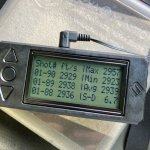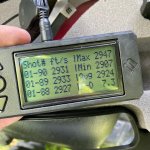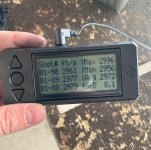So, I'm new fairly new to reloading. Taking in all the information I can. I watch a lot of videos and other things. This however was intriguing. Reloading all day on I.G, and they have a website reloadingallday.com these people or person seems to know a lot. Ballisticians, talks with a lot of experts. etc. Here is my conversation. In the picture. He is saying through extensive testing that seating depth does not do anything for the accuracy of a rifle. Anyone find this to be true or complete B.S. he seems to know his stuff.
- Thread starter Dildobaggins
- Start date
You are using an out of date browser. It may not display this or other websites correctly.
You should upgrade or use an alternative browser.
You should upgrade or use an alternative browser.
I don't think that's what he is saying here. I'm not going to venture into the harmonics vs bullet jump ect arguments and there are lots here who know more than i do about it so I will defer to them.So, I'm new fairly new to reloading. Taking in all the information I can. I watch a lot of videos and other things. This however was intriguing. Reloading all day on I.G, and they have a website reloadingallday.com these people or person seems to know a lot. Ballisticians, talks with a lot of experts. etc. Here is my conversation. In the picture. He is saying through extensive testing that seating depth does not do anything for the accuracy of a rifle. Anyone find this to be true or complete B.S. he seems to know his stuff.
Thank you. Not trying to shit on anyone either. Like I said I'm new to all of this. Just curious on everyone's thoughts.I don't think that's what he is saying here. I'm not going to venture into the harmonics vs bullet jump ect arguments and there are lots here who know more than i do about it so I will defer to them.
Well, to parse semantics, the accuracy (potential) of a rifle itself does not change according to the load or ammunition you use in it. The individual accuracy of the ammunition depends upon a lot of things.
However, if he is making a blanket statement that seating depth has no relation to the performance of a load in a rifle then I think he had better have a lot of data and testing to back up that statement.
However, if he is making a blanket statement that seating depth has no relation to the performance of a load in a rifle then I think he had better have a lot of data and testing to back up that statement.
Depends on the bullet you’re using. Ive ran/run sierra 175smks, 169smks everywhere from .030 to .170 off the lands across numerous 308 rifles including the three I currently own and all shot well when the recipe was optimized and production process well controlled. Same with Berger hybrids - seating depth doesn’t matter much unless you’re too close to the lands.
Modern tangent and hybrid ogive bullets make it easy to get good precision (not “accuracy”- accuracy is simply hitting what you’re aiming at) all ofher things equal.
VLD bullets are a diff story.
Modern tangent and hybrid ogive bullets make it easy to get good precision (not “accuracy”- accuracy is simply hitting what you’re aiming at) all ofher things equal.
VLD bullets are a diff story.
Seating depth definitely effects accuracy. Exactly why, how much, the causes of, ect... seating depth effecting accuracy is another matter.Thank you. Not trying to shit on anyone either. Like I said I'm new to all of this. Just curious on everyone's thoughts.
I think he's saying that it isn't the seating depth itself, it's the change in harmonics produced by the seating depth but it's kind of hard to know what he is saying from just that little bit.Well, to parse semantics, the accuracy (potential) of a rifle itself does not change according to the load or ammunition you use in it. The individual accuracy of the ammunition depends upon a lot of things.
However, if he is making a blanket statement that seating depth has no relation to the performance of a load in a rifle then I think he had better have a lot of data and testing to back up that statement.
See, I think that you got the nail on the head. He’s playing semantics with the words.Modern tangent and hybrid ogive bullets make it easy to get good precision (not “accuracy”- accuracy is simply hitting what you’re aiming at) all ofher things equal.
Hey guys. Blake here from RAD. If you have any questions I’ll help as much as I can. What the OP is referring to is that I’ve been lucky enough to be mentored by our internal ballistics ballistician and witness some really neat things, among myself when challenging under high sample size testing and proofing.
I’m not sure how to tag on here cause I never use the hide, but @BuildingConceptsllc is on the right track. I’m talking about in relationship into vibrational waves among optimal barrel timing.
There are ways, among a certain “seating depths” that have more to do with supporting the projectile before launch and engravement and using the barrel geometry to your advantage which is more vital than a “vibrational node” that one may be chasing with optimal barrel timing. We will be releasing data soon showing what’s going on in the internal and intermediate process of ballistics.
I’ve personally done testing outside, among with our students, with mathematically calculating where powder charges will “yield” the most consistent ignition and results as seen attached with 90 rounds recorded on 3 separate days.
This is a very sensitive subject and I know a lot of personal feelings will get mixed up in this. Not trying to start anything. And I hope individuals don’t get upset that I have an opposing view. However, I understand objective data is very important and will be more than happy to answer any questions as much as I can.
I’m not sure how to tag on here cause I never use the hide, but @BuildingConceptsllc is on the right track. I’m talking about in relationship into vibrational waves among optimal barrel timing.
There are ways, among a certain “seating depths” that have more to do with supporting the projectile before launch and engravement and using the barrel geometry to your advantage which is more vital than a “vibrational node” that one may be chasing with optimal barrel timing. We will be releasing data soon showing what’s going on in the internal and intermediate process of ballistics.
I’ve personally done testing outside, among with our students, with mathematically calculating where powder charges will “yield” the most consistent ignition and results as seen attached with 90 rounds recorded on 3 separate days.
This is a very sensitive subject and I know a lot of personal feelings will get mixed up in this. Not trying to start anything. And I hope individuals don’t get upset that I have an opposing view. However, I understand objective data is very important and will be more than happy to answer any questions as much as I can.
Attachments
Well I think we all love some date so bring it on. This is definitely a touchy topic but if you have data to back it up then come on with it. I absolutely love these threads that have actual data in them. (A 5 shot group isn't data) and it's awesome to see someone with some real data. Can't wait to see it.Hey guys. Blake here from RAD. If you have any questions I’ll help as much as I can. What the OP is referring to is that I’ve been lucky enough to be mentored by our internal ballistics ballistician and witness some really neat things, among myself when challenging under high sample size testing and proofing.
I’m not sure how to tag on here cause I never use the hide, but @BuildingConceptsllc is on the right track. I’m talking about in relationship into vibrational waves among optimal barrel timing.
There are ways, among a certain “seating depths” that have more to do with supporting the projectile before launch and engravement and using the barrel geometry to your advantage which is more vital than a “vibrational node” that one may be chasing with optimal barrel timing. We will be releasing data soon showing what’s going on in the internal and intermediate process of ballistics.
I’ve personally done testing outside, among with our students, with mathematically calculating where powder charges will “yield” the most consistent ignition and results as seen attached with 90 rounds recorded on 3 separate days.
This is a very sensitive subject and I know a lot of personal feelings will get mixed up in this. Not trying to start anything. And I hope individuals don’t get upset that I have an opposing view. However, I understand objective data is very important and will be more than happy to answer any questions as much as I can.
I read this to mean that seating depth adjustment does not alter the barrel harmonics.
Hey @BuildingConceptsllc! I cannot legally provide specific data that is not mine to give as our ballistican is actively showing what is going on in the internal process. Once it is available, I’ll be sure to link it here.Well I think we all love some date so bring it on. This is definitely a touchy topic but if you have data to back it up then come on with it. I absolutely love these threads that have actual data in them. (A 5 shot group isn't data) and it's awesome to see someone with some real data. Can't wait to see it.
If you are interested in reading about vibrations at the muzzle from other internal ballisticians talking about this concept you can find some material here, particularly page 10-15:
As far as other topics such as tuners and timing, I would refer to applied ballistics, Bryan Litz Volume 3 where they show objectively talking about how tuners do not work.
I would be more than happy to provide data from groups being shot. However, considering the rifle recoils before projectile exit, we have to completely isolate the shooter to show what is actually going on in the internal process for this to be proven in what we are talking about.
Last edited:
First, be clear what one means by "seating depth". Very often in many forums, when seating depth is mentioned, they are mistakenly referring to "jump" or adjustments for how far they are from the lands. This often makes things very confusing since "seating depth" is actually referring to how far the projectile is seated into the case and has nothing to do with how far one is from the lands (though there is some relationship for a given freebore).So, I'm new fairly new to reloading. Taking in all the information I can. I watch a lot of videos and other things. This however was intriguing. Reloading all day on I.G, and they have a website reloadingallday.com these people or person seems to know a lot. Ballisticians, talks with a lot of experts. etc. Here is my conversation. In the picture. He is saying through extensive testing that seating depth does not do anything for the accuracy of a rifle. Anyone find this to be true or complete B.S. he seems to know his stuff.
What's important with a change in the seating depth is that it changes interior volume that the charge of powder has to work in. Lower the volume in the case for a particular powder charge and the spike in pressure goes up resulting in higher velocity. Increase the volume in the case and the spike in pressure goes down as will the velocity. This is a very easy thing to test yourself just by comparing a couple of seating depths at something like .020 or .030" apart with the same projectile and powder charge and see what kind of MV differences you get.
Along with the difference in velocities you can see, you can also see what that amount of velocity difference makes on paper . . . particularly at longer distances.
Besides a change in velocity that a difference in seating depth can make, there also what call "barrel time", the time it takes the bullet to fully exit the muzzle. Altering the seating depth changes the distance the projectile is from the muzzle. While that's a factor, it's in combination with a change in pressure/velocity, which is really not the only factors a place. But, seating depth is a major one.
Notice at the end of Berger's recommendation (and they've done A LOT of testing), that after one has found a distance from the lands that better than others, to "tweak" the seating depth adjustments in "+/- .002 or .005". Though they refer to adjustments in COAL because that's a better reference for any projectile as reference than things like BTO's can given that they have big variances depending on comparators or whatever other tool that my be used to measure BTO's for seating. They're really talking about adjustment in seating depth.

Getting the Best Precision and Accuracy from VLD bullets in Your Rifle
VLD bullets are designed with a secant ogive. This ogive shape allows bullets to be more efficient in flight (retain more velocity = less drop and wind deflection). While this result is desirable for many rifle shooters the secant ogive on the VLD bullets produces another result in many rifle.
Last edited:
I'll stick this article here also as I noticed my randomly picked COAL, with approximately 0.08" jump, showed great groups during charge testing. So far it averages 0.56 moa with average distance being 340yds. Groups of 5 and few 3 shots.
I had scope loose / poorly attached for 2 groups, it printed 4 separate groups of .12, .17 and .11 and .12 moa at 300m, the shots stilI hit within 1.03moa.
I have never been more puzzled as then. But it seems to work very well when the scope is attached properly. (0.68 moa overall average, with loose scope groups)
This is what I found was the reason to the success:
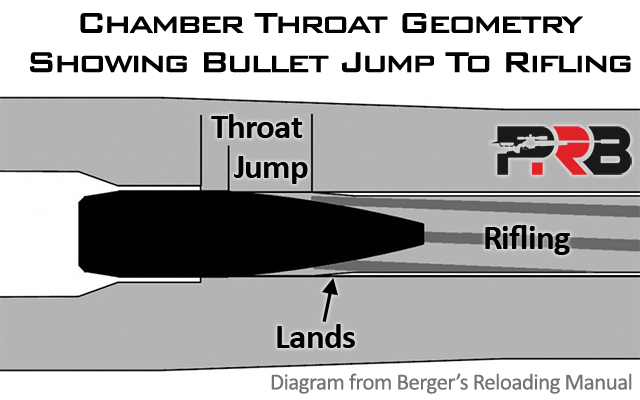
 precisionrifleblog.com
precisionrifleblog.com
I had scope loose / poorly attached for 2 groups, it printed 4 separate groups of .12, .17 and .11 and .12 moa at 300m, the shots stilI hit within 1.03moa.
I have never been more puzzled as then. But it seems to work very well when the scope is attached properly. (0.68 moa overall average, with loose scope groups)
This is what I found was the reason to the success:

Bullet Jump Research: Executive Summary & Load Development Tips
This is the last post in a series of articles focused on bullet jump research that has been conduct...
Wow 
Been reading some of the links for the past couple of hours and have to stop.
I'm not such a precise shooter that 0.005" in jump will make a drastic change. Just not something I'm going to see.
But, the wide window approach does make sense. A jump test with a new bullet (like the 85.5) does show group size variations, so I'm as least that good
Am I going to start checking freebore every 100 rounds? Probably not.
I sort of keep track of rounds fired and have 2 similar barrels that have very different round counts.
One has "about" 1500 rounds, and the other about 300. A caliber that has been suggested to be a "barrel burner", the 22 Nolser.
Both barrels are from one maker, 28", 1:7, 5R, 0.219".
The freebore has grown and after light polishing still appears OK with a borescope.
Here is my latest loadings for each barrel with Berger 85.5gr bullets.
Old barrel, New barrel, 85.5 and 88ELD

I tried to set jump to 0.020" for 85.5, 0.030" for the 88ELD. With practice/load work and F-Open matches being 60+ rounds, and the opportunity to rezero as the round count goes up I'll be checking length every few hundred rounds. Maybe I'll let jump increase some as I go.
Been reading some of the links for the past couple of hours and have to stop.
I'm not such a precise shooter that 0.005" in jump will make a drastic change. Just not something I'm going to see.
But, the wide window approach does make sense. A jump test with a new bullet (like the 85.5) does show group size variations, so I'm as least that good
Am I going to start checking freebore every 100 rounds? Probably not.
I sort of keep track of rounds fired and have 2 similar barrels that have very different round counts.
One has "about" 1500 rounds, and the other about 300. A caliber that has been suggested to be a "barrel burner", the 22 Nolser.
Both barrels are from one maker, 28", 1:7, 5R, 0.219".
The freebore has grown and after light polishing still appears OK with a borescope.
Here is my latest loadings for each barrel with Berger 85.5gr bullets.
Old barrel, New barrel, 85.5 and 88ELD
I tried to set jump to 0.020" for 85.5, 0.030" for the 88ELD. With practice/load work and F-Open matches being 60+ rounds, and the opportunity to rezero as the round count goes up I'll be checking length every few hundred rounds. Maybe I'll let jump increase some as I go.
Last edited:
this year I couldn't and couldn't find a good load in 223REM with N140 and Sierra 95gr, but when I was so desperate and moved to 0.080' jump (first time in 223REM calibre ever), than it makes sense!!
group was finaly GOOD!
so this long jumps makes sense too.
group was finaly GOOD!
so this long jumps makes sense too.
What's important with a change in the seating depth is that it changes interior volume that the charge of powder has to work in. Lower the volume in the case for a particular powder charge and the spike in pressure goes up resulting in higher velocity. Increase the volume in the case and the spike in pressure goes down as will the velocity. This is a very easy thing to test yourself just by comparing a couple of seating depths at something like .020 or .030" apart with the same projectile and powder charge and see what kind of MV differences you get.
all internet is wrong about this and it wont be right anytime soon.
for those small jump sessions, what we are doing (0.030' jump etc), when you increase jump, velocity and pressure will DROP. because of bullet jump to rifling.
way way shorter, it will came to different effect, where shorter cartridge will produce higher pressure and higher velocity.
but in our dimensions when chasing lands, shorter ammo = slower ammo.
The way the statement is worded is not him saying seating depth doesn’t change accuracy. He’s saying it’s not due to timing or harmonics. And I’d have to agree just on the grounds that moving a bullet .005 is not changing timing/harmonics enough to matter. I’ve always been suspect of that claim. I’d guess it has more to do with pressure and bullet alignment. Either way it doesn’t really matter WHY it changes. Knowing the exact mechanism could be helpful but if you just do a test and find what makes your bullet happy that’s all that really matters in the field.
Jayden Quinlan the Hornady ballistician touches on seating depth in one of the recent hornady podcasts. The interior ballistics one talks about it.
It’s a subject he doesn’t completely cover but does goes over why seating depth may have an impact on precision. Specifically that it changes how the bullet engraves in the barrel.
Worth checking out…
From my own experience, seating depth for many bullets has the most dramatic load dev influence and I now do a seating depth test before charge weight. There are some bullets that pretty much work wherever… berger hybrids are the ones I’ve seen just not care. Most others do though.
It’s a subject he doesn’t completely cover but does goes over why seating depth may have an impact on precision. Specifically that it changes how the bullet engraves in the barrel.
Worth checking out…
From my own experience, seating depth for many bullets has the most dramatic load dev influence and I now do a seating depth test before charge weight. There are some bullets that pretty much work wherever… berger hybrids are the ones I’ve seen just not care. Most others do though.
I love the article and data he's produced, but it's a case in point where his reference to jump is more about seating depth than jump, especially like when he says "changing bullet jump by 0.002-0.005 inches can potentially have a dramatic affect precision."I'll stick this article here also as I noticed my randomly picked COAL, with approximately 0.08" jump, showed great groups during charge testing. So far it averages 0.56 moa with average distance being 340yds. Groups of 5 and few 3 shots.
I had scope loose / poorly attached for 2 groups, it printed 4 separate groups of .12, .17 and .11 and .12 moa at 300m, the shots stilI hit within 1.03moa.
I have never been more puzzled as then. But it seems to work very well when the scope is attached properly. (0.68 moa overall average, with loose scope groups)
This is what I found was the reason to the success:

Bullet Jump Research: Executive Summary & Load Development Tips
This is the last post in a series of articles focused on bullet jump research that has been conduct...precisionrifleblog.com
I used to chase the lands in order to maintain a jump that my load development gave me good accuracy. And I would have to redo my load development every so often to maintain accuracy as my throat eroded. Finally, I decided to not chase the lands and keep the seating depth the same until I would lose accuracy. In my .308 with over 2000 rounds later and the throat having eroded .030" (meaning my jump has increase .030), I was still getting the accuracy I had all the while. Some time later I hear some well known champion shooters (like Speedy) say they'll not change their seating depth for the life of their barrel (which for them is relatively a short period). These days, I only pay attention to jump as a starting point for load development and ignore it from then on.
Last edited:
Unfortunately, we often attribute a cause and effect to one variable under the assumption that we only change that variable when in reality we change several variables in making that one change and then judge the results of the basis of a total system that responds to all of the variables. A change in seating depth affects case volume, it affects barrel time, it may affect pressure and velocity, it might affect bullet alignment, just to name a few. Do chamber differences effect the results? We seldom know the exact effects of each on the target and/or the the repeatability of those effects.
The point is that what happens in one instance may or may not have the same result in a different instance.
The point is that what happens in one instance may or may not have the same result in a different instance.
Yes you’re right but seating depth does not affect those variables to the point where it starts to affect barrel harmonics.
The whole point to changing seating depth is to time bullet exit so they all come out at the same time relative to barrel muzzle travel.
Seating a bullet .005” deeper will not increase velocity. It will not increase pressure. It will not change the way the barrel flops around. But it will increase the amount of time that bullet spends in the barrel.
The whole point to changing seating depth is to time bullet exit so they all come out at the same time relative to barrel muzzle travel.
Seating a bullet .005” deeper will not increase velocity. It will not increase pressure. It will not change the way the barrel flops around. But it will increase the amount of time that bullet spends in the barrel.
Complicated, ain't it 
Seating depth, jump, jam, bearing surface engagement, 0.002" to 0.005", or 0.050" to 0.080".
With something like a .224" diameter projectile, 0.080" is a lot when it comes to bearing surface engagement of the bullet with the neck.
For those that spec'd their chamber's freebore to JAM a particular bullet waiting for 0.080" throat erosion is gonna cost some points.
I can tell when I fire a group of rounds loaded for the New barrel in the Old barrel.
Eventually erosion will require a barrel swap but for now I have plenty of neck to chase the lands a little more.
Touch was measured with a really loose neck, eased into the chamber (AR) with glue inside. Left to cure muzzle down.

Seating depth, jump, jam, bearing surface engagement, 0.002" to 0.005", or 0.050" to 0.080".
With something like a .224" diameter projectile, 0.080" is a lot when it comes to bearing surface engagement of the bullet with the neck.
For those that spec'd their chamber's freebore to JAM a particular bullet waiting for 0.080" throat erosion is gonna cost some points.
I can tell when I fire a group of rounds loaded for the New barrel in the Old barrel.
Eventually erosion will require a barrel swap but for now I have plenty of neck to chase the lands a little more.
Touch was measured with a really loose neck, eased into the chamber (AR) with glue inside. Left to cure muzzle down.
Complicated, ain't it
Seating depth, jump, jam, bearing surface engagement, 0.002" to 0.005", or 0.050" to 0.080".
With something like a .224" diameter projectile, 0.080" is a lot when it comes to bearing surface engagement of the bullet with the neck.
For those that spec'd their chamber's freebore to JAM a particular bullet waiting for 0.080" throat erosion is gonna cost some points.
I can tell when I fire a group of rounds loaded for the New barrel in the Old barrel.
Eventually erosion will require a barrel swap but for now I have plenty of neck to chase the lands a little more.
Touch was measured with a really loose neck, eased into the chamber (AR) with glue inside. Left to cure muzzle down.
Nah, you either have jump or jam, they can be in the same discussion if a person knows what the hell the difference is .Loading to "jam" is a whole other discussion and can't really even be compared to loading with a jump.

Agreed that those small variations should have no discernible effect on most of the variables. However, I do question (not meant be be argumentative) as to whether the test results that we see and use are actually correct. How many times are the test repeated? I actually backed into a conflicting situation when I ran a test on the 52 Berger Target. I ran 3 shots at 100yds for three depths and there was a clear winner. I took it to 300yds and another was the clear winner. Seating depth or shooter? Was I inside the node? Environmental?Yes you’re right but seating depth does not affect those variables to the point where it starts to affect barrel harmonics.
The whole point to changing seating depth is to time bullet exit so they all come out at the same time relative to barrel muzzle travel.
Seating a bullet .005” deeper will not increase velocity. It will not increase pressure. It will not change the way the barrel flops around. But it will increase the amount of time that bullet spends in the barrel.
This is why I test the test results and look for that which is repeatable.Agreed that those small variations should have no discernible effect on most of the variables. However, I do question (not meant be be argumentative) as to whether the test results that we see and use are actually correct. How many times are the test repeated? I actually backed into a conflicting situation when I ran a test on the 52 Berger Target. I ran 3 shots at 100yds for three depths and there was a clear winner. I took it to 300yds and another was the clear winner. Seating depth or shooter? Was I inside the node? Environmental?
That is the part that seems to be missing so often. I didn't repeat my test just loaded and shot the 300yd result. In this case its a 300yd load its suitable. I might load the other one and shoot a comparison just for the heck of it!This is why I test the test results and look for that which is repeatable.
This whole thread is a cluster fuck of semantics and you have to really understand everything to comprehend what is trying to be conveyed.
In short yes seating depth will play a large part of the accuracy of your round
In short yes seating depth will play a large part of the accuracy of your round
Hey @BuildingConceptsllc! I cannot legally provide specific data that is not mine to give as our ballistican is actively showing what is going on in the internal process. Once it is available, I’ll be sure to link it here.
If you are interested in reading about vibrations at the muzzle from other internal ballisticians talking about this concept you can find some material here, particularly page 10-15:
As far as other topics such as tuners and timing, I would refer to applied ballistics, Bryan Litz Volume 3 where they show objectively talking about how tuners do not work.
I would be more than happy to provide data from groups being shot. However, considering the rifle recoils before projectile exit, we have to completely isolate the shooter to show what is actually going on in the internal process for this to be proven in what we are talking about.
Litz did a flawed test and got flawed results. Tuners absolutely work especially in rimfire but also in centerfire rifles
Litz thinks primer seating depth doesn't matter either... yet myself and many have found that it absolutely does. Now he comes out and says tuners don't work, when I've been seeing them work wonders on rimfires and centerfires for over two decades. The fact that they work, isn't even up for debate. Now if he wanted to say the reason why they work, isn't the reason we thought they worked... then there'd be something to talk about. ...but that's not what he said. So he's slowly losing credibility with me outside of his work as a ballistician. Twice now, in the last year, he's missed the mark big time.Litz did a flawed test and got flawed results. Tuners absolutely work especially in rimfire but also in centerfire rifles
I love his work with their ballistic solver... but he should probably stick to what he actually knows, rather than what he thinks he knows.
Food for thought.Seating a bullet .005” deeper will not increase velocity. It will not increase pressure. It will not change the way the barrel flops around. But it will increase the amount of time that bullet spends in the barrel.
The time a bullet spends in a barrel is a combination of velocity (as measured at the muzzle) and the length of the barrel.
If a bullet is sitting on the lands when ignition happens, it is at zero fps as it enters the barrel. Let's say it exits at 3000 fps from a 30" barrel. Its average velocity from entry to exit is (0+3000)/2=1500 fps and it spends 2.5'/1500 fps=0.001666666666667 seconds in the 30" barrel.
What happens if the bullet is moving already when it hits the lands as it would when you have a jump situation? For the sake of making a point, let's say that bullet is already moving at 1000 fps as it hits the lands and exits at the same 3000 fps. Average velocity is now (1000+3000)/2=2000 fps. That bullet is now spending 0.00125 seconds in the 30" barrel. Less time.
Litz thinks primer seating depth doesn't matter either... yet myself and many have found that it absolutely does.
you and others only find that we must seat primers to the end of primer pocket and nothing else.
and this is what pleople are doing the whole time with cheap lee primer and doesnt need you expencive toy to prove that.
so your point is that we need your primer seater to prove that our seating technique with cheap lee primer seater is as good as with your toy?
Food for thought.
The time a bullet spends in a barrel is a combination of velocity (as measured at the muzzle) and the length of the barrel.
If a bullet is sitting on the lands when ignition happens, it is at zero fps as it enters the barrel. Let's say it exits at 3000 fps from a 30" barrel. Its average velocity from entry to exit is (0+3000)/2=1500 fps and it spends 2.5'/1500 fps=0.001666666666667 seconds in the 30" barrel.
What happens if the bullet is moving already when it hits the lands as it would when you have a jump situation? For the sake of making a point, let's say that bullet is already moving at 1000 fps as it hits the lands and exits at the same 3000 fps. Average velocity is now (1000+3000)/2=2000 fps. That bullet is now spending 0.00125 seconds in the 30" barrel. Less time.
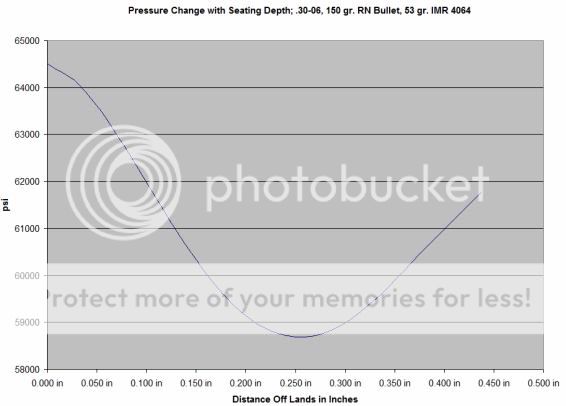
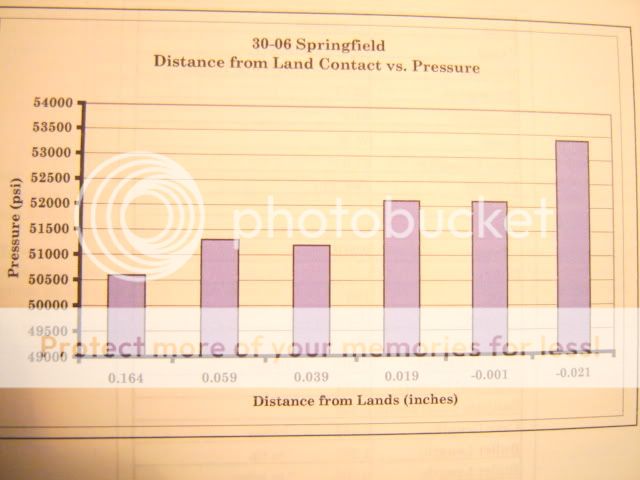
Notice that my post had NOTHING to do with pressure? I'm not sure why you would post pics of pressure in response to my post.
To stir the pot?Notice that my post had NOTHING to do with pressure? I'm not sure why you would post pics of pressure in response to my post.
Now add a difference of.0005 to headspace of the brass and differences in neck tension to the seating depth. Some here may have a laboratory to perfectly control all variables. But most are reloading in a house or garage where temperature swings can also have an effect on the reloads. Controlled environment, calibrated laboratory grade equipment, and machines firing the weapon for repeatability in an environmentally controlled area is what is needed to prove a thesis.
Or...and much more likely, a lack of reading comprehension skills.To stir the pot?
Have you ever heard of LDS? Sounds like you got a bad case brotha. LolOr...and much more likely, a lack of reading comprehension skills.
Have I told you lately that I like your DSL?Have you ever heard of LDS? Sounds like you got a bad case brotha. Lol
You're too kind.Have I told you lately that I like your DSL?
Litz did a flawed test and got flawed results. Tuners absolutely work especially in rimfire but also in centerfire rifles
Curious how the test was flawed? Or how someone might think it’s flawed? (This is a genuine question)
From what I have tested , seating depth primarily effects 2 things . Velocity variation and also causes a random dispersion at certain depths . The volume of powder can effect this as well . At certain volumes the velocity variance can be effected less or more .I have not found a bullet yet that was not effected by this variable. Average change in jump has been approximately .004-.005 before small spikes in velocities start to appear again but again this depends on the volume occupied by the powder at the time .
timintx
timintx
Last edited:
I started my 6.5 CM reloading by mimicking the factory ammo I started with - once fired Hornady brass from 300 rounds of Hornady 147 gr. ELDMs. I reloaded to factory length and played with charges of RL26 and later H4350 to get the same/similar zero at 100 and 200 yards. I computed relative velocity using DOPE and Strelok Pro Ballistics App.
Then I started playing with seating depth and, for the life of me, it has never improved the accuracy of my hand loads. It obviously changes velocity and thus the zero changes (sometimes a lot) but the group size does not get significantly bigger/smaller no matter the COAL. I always resize after each firing. Maybe it's me or maybe it's this particular rifle but it just doesn't care about COAL or how close to/far away from the lands I am.
That's my perspective.
VooDoo
Then I started playing with seating depth and, for the life of me, it has never improved the accuracy of my hand loads. It obviously changes velocity and thus the zero changes (sometimes a lot) but the group size does not get significantly bigger/smaller no matter the COAL. I always resize after each firing. Maybe it's me or maybe it's this particular rifle but it just doesn't care about COAL or how close to/far away from the lands I am.
That's my perspective.
VooDoo
Seat .025-.045 off the lands. Don't worry about it again.
I'm not going to say it completely doesn't matter, but in terms of things you can change to affect precision, seating depth is one of those that takes a lot of testing to produce small improvements.
I'm not going to say it completely doesn't matter, but in terms of things you can change to affect precision, seating depth is one of those that takes a lot of testing to produce small improvements.
I have seen that too ,I wish that was the case on all of my rifles , some are effected differently . When I set my depth for level velocities certain variables must be controlled. I always clean the barrel then shoot 7 rounds through the barrel to season it then let it cool . Shoot 2 or 3 shots , if they are not level then change depth .003 at a time , until I get to 20 rounds . Then clean and repeat until I have found a spot where the velocities are level and It shoots good groups. If the barrel heats up past 110 degrees , I also let it cool because just the heat alone will cause the velocities to spike . Every barrel has its own velocity patterns . But I wait until the barrel broke in or has at least 100 or so rounds through it before seating depth is really tested with any confidence .I started my 6.5 CM reloading by mimicking the factory ammo I started with - once fired Hornady brass from 300 rounds of Hornady 147 gr. ELDMs. I reloaded to factory length and played with charges of RL26 and later H4350 to get the same/similar zero at 100 and 200 yards. I computed relative velocity using DOPE and Strelok Pro Ballistics App.
Then I started playing with seating depth and, for the life of me, it has never improved the accuracy of my hand loads. It obviously changes velocity and thus the zero changes (sometimes a lot) but the group size does not get significantly bigger/smaller no matter the COAL. I always resize after each firing. Maybe it's me or maybe it's this particular rifle but it just doesn't care about COAL or how close to/far away from the lands I am.
That's my perspective.
VooDoo
timintx
To those that are saying it doesn't make a difference in your rifle are you making small changes (.003" at a time) or large changes? I find really good seating depth windows are very narrow. It's easy to get moderate accuracy from any seating depth but if you really bring it in that's when they shoot small.
Last edited:
.003" at a time for me. I'd load 10 of each and shoot 5 round groups and let the barrel cool way down between sets 5. The gun is a Savage 10 in an MDT chassis and Area 419 brake but to be fair the gun was a consistent .7 MOA shooter right out of the box with the crappy plastic stock. Now with all the goodies and load development it is a consistent .5 MOA gun and I'm the weakest link. My nephew shoots this rifle extremely well (better than he shoots his own ) as does my brother when we all shoot together.
Might just be this particular rifle. It's my first and only so I'm lacking experience with other guns/other loads. I anticipate shooting the barrel out next season as I'm at about 2500 rounds right now. It'll be interesting if a new barrel is the same when I work up loads for it.
VooDoo
Might just be this particular rifle. It's my first and only so I'm lacking experience with other guns/other loads. I anticipate shooting the barrel out next season as I'm at about 2500 rounds right now. It'll be interesting if a new barrel is the same when I work up loads for it.
VooDoo
Similar threads
- Replies
- 87
- Views
- 3K
- Replies
- 104
- Views
- 3K
- Replies
- 33
- Views
- 1K


